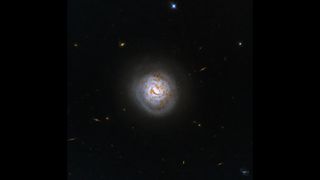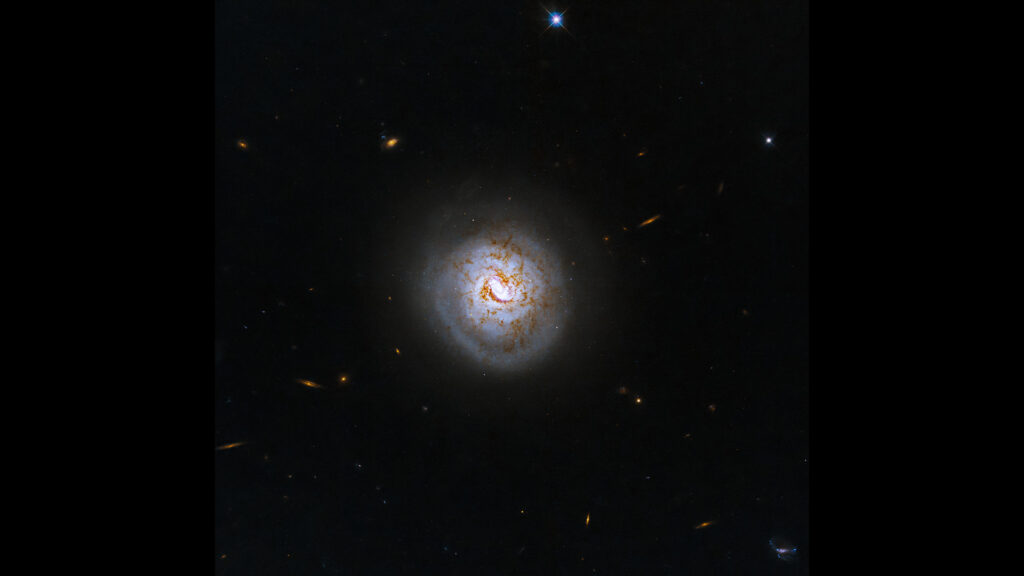
ESO 420-G013’s perfectly round disk of stars resembles a baseball. Image credit:
(Image credit: NASA/ESA/A. Evans (University of Virginia)/Processing: Gladys Kober (NASA/Catholic University of America))
What it is: ESO 420-G013, an extremely bright face-on spiral galaxy harboring a hungry black hole
When it was taken: Jan. 30, 2024
Where it is: 50 million light-years from Earth in the constellation Sculptor
Why it’s so special: This image from the Hubble Space Telescope captures the dark dust lanes of a rare kind of spiral galaxy against the glow of thousands of stars.
The image shows a bright core and brownish filaments of dark dust, but the galaxy’s almost perfectly round disk is its most notable feature. That’s because Hubble, which has been in orbit around Earth since 1990, just happens to have a direct face-on view of ESO 420-G013.
Besides being a fine example of a spiral galaxy, ESO 420-G013 is a Seyfert galaxy. Named after American astronomer Carl Keenan Seyfert, who researched the objects in 1943, a Seyfert galaxy has an extremely bright, point-like active galactic nucleus powered by a supermassive black hole, according to a NASA statement. Deep within ESO 420-G013, its hungry black hole is pulling in surrounding material and sending out powerful radiation. It’s also forming new stars at a high rate.
Related: Right again, Einstein: New snapshot of 1st black hole to be photographed confirms relativity
A zoomed-in view of the face-on spiral galaxy ESO 420-G013 (Image credit: NASA/ESA/A. Evans (University of Virginia)/Processing: Gladys Kober (NASA/Catholic University of America))
Seyfert galaxies like this one are visible in the infrared — wavelengths of light beyond those visible to humans in the electromagnetic spectrum — which Hubble can detect thanks to its Wide Field Camera 3, which is sensitive to ultraviolet, visible and infrared light.
What’s special about ESO 420-G013 is its visibility. Most galaxies with active galactic nuclei host black holes so bright that their radiation entirely obscures the light of the host galaxy. However, Seyfert galaxies such as ESO 420-G013 are distinct, because the surrounding galaxy structure can be clearly detected.
ESO 420-G013 was captured by Hubble as part of research on luminous infrared galaxies, which are known for their intense brightness in the infrared spectrum.
Get the world’s most fascinating discoveries delivered straight to your inbox.
Jamie Carter is a freelance journalist and regular Live Science contributor based in Cardiff, U.K. He is the author of A Stargazing Program For Beginners and lectures on astronomy and the natural world. Jamie regularly writes for Space.com, TechRadar.com, Forbes Science, BBC Wildlife magazine and Scientific American, and many others. He edits WhenIsTheNextEclipse.com.
>>> Read full article>>>
Copyright for syndicated content belongs to the linked Source : Live Science – https://www.livescience.com/space/cosmology/space-photo-of-the-week-hubble-catches-a-baseball-galaxy-with-a-black-hole-heart
